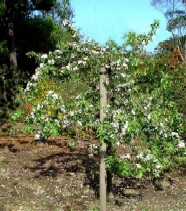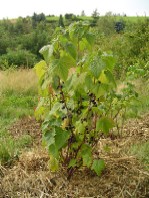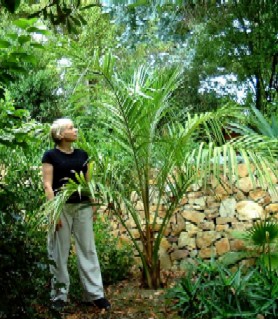David Robinson / Plants that changed my life - The Horticulturist
Previous / Next: Other articles and papers
Plants that changed my life
 The
following article was written by David Robinson for the Autumn 2003 edition of
the The Horticulturist. [Volume 12 No. 4, Autumn 2003], shortly before he was
taken ill.
The
following article was written by David Robinson for the Autumn 2003 edition of
the The Horticulturist. [Volume 12 No. 4, Autumn 2003], shortly before he was
taken ill.
David Robinson decided on a horticultural career aged ten. His top ten plants reflect the changing emphasis in horticulture in the second half of the 20th century; taking him from crop production to the aesthetic and functional use of plants and into horticultural tourism.
I was unaware of the extent to which plants have changed my life until I
began to write this article. Nor was I fully conscious, until forced to think
retrospectively, of the rich and varied experiences that a career in
horticulture can provide. I was especially fortunate in having the opportunity
to travel to over 70 countries on horticultural business for every place is
different and had something to teach. I was also surprised to see how the 10
plants selected reflect the changing emphasis in horticulture in the second half
of the 20th century.
Senecio vulgaris (Groundsel)
 I
was around ten years old when I decided on horticulture as a career. My father
was a small-scale builder and, as times were hard during the 1930s, he augmented
his income by selling bedding plants in the
I
was around ten years old when I decided on horticulture as a career. My father
was a small-scale builder and, as times were hard during the 1930s, he augmented
his income by selling bedding plants in the
When I took up my position at the recently established Loughgall Horticultural Centre in 1953, I was asked to carry out applied research on soft fruits. I evaluated cultivars, conducted nutritional trials but the main thrust of my work was on weed control. I would like to think that this was an objective decision based on the main need of the industry but I have a feeling that my early tussles with groundsel and other weeds also played a part.
Fifty years later, I remain preoccupied with groundsel as it still also occurs occasionally in my 7 acre garden which has been maintained with the use of simazine and other herbicides since 1969. As I make strenuous efforts to prevent weeds from seeding, there is still no evidence of any build-up of simazine-resistant groundsel after 34 years. [*]
Malus sylvestris X M. pumila (Apple)
 After
graduation, my first job was as Horticultural Adviser in South Down. In 1953 I
had an agricultural colleague who had recently been rejected by his girlfriend
but was striving for reconciliation. When his ex girlfriend’s mother asked him
for advice on her non-fruiting apple tree, he turned to me for help. Clinging to
the belief that solving the mother’s apple problem would help his case with the
daughter, we paid them a visit. It was a fruitful advisory meeting although not
as planned as I failed to impress the mother. However I made a much better
impression on the daughter and two years later we married.
After
graduation, my first job was as Horticultural Adviser in South Down. In 1953 I
had an agricultural colleague who had recently been rejected by his girlfriend
but was striving for reconciliation. When his ex girlfriend’s mother asked him
for advice on her non-fruiting apple tree, he turned to me for help. Clinging to
the belief that solving the mother’s apple problem would help his case with the
daughter, we paid them a visit. It was a fruitful advisory meeting although not
as planned as I failed to impress the mother. However I made a much better
impression on the daughter and two years later we married.
Fragaria Xananassa (Strawberry)
During the 1950s, aided by a steady stream of new herbicides, our work in
Northern Ireland made rapid progress and the
weed problem in strawberries and other crops greatly diminished. In February
1959, I accepted an invitation from John Daly, Horticultural Instructor in Co.
Wexford,
 I
was impressed with the enthusiasm of the over 300 growers who attended the
lecture and I could see that growing conditions in the south east of the island
were better than they were further north. Invitations to lecture on strawberries
in other parts of the Republic followed, so my work with this crop gave me
experience of parts of
I
was impressed with the enthusiasm of the over 300 growers who attended the
lecture and I could see that growing conditions in the south east of the island
were better than they were further north. Invitations to lecture on strawberries
in other parts of the Republic followed, so my work with this crop gave me
experience of parts of
When I was offered a position at Kinsealy Research Centre,
There was, of course, no truth in the story circulated by my facetious former
colleagues at Loughgall that I was obliged to move on to fresh fields as I had
contaminated so much land in the north with herbicides.
Ribes nigrum (Blackcurrant)
The year 1958 was memorable as two remarkable herbicides, simazine and paraquat, with complementary properties became available for trial purposes. By using simazine to control germinating weeds and paraquat to suppress any survivors, it became possible for the first time to grow fruit crops virtually weed-free without cultivation. My colleagues and I conducted many trials, which showed clearly that higher yields could be obtained when cultivation, such as hoeing or rotavating, was eliminated. When not disturbed, the soil surface formed a crust, which often became covered with moss and looked the antithesis of a well-structured soil. But we could not ignore the evidence that plants were growing and yielding better despite the grim forebodings of many soil scientists at the time.
 We
noticed that blackcurrant bushes that had been left non-cultivated all season
made vigorous root growth right at the soil surface. Subsequent careful
excavations in this crop and others showed that in weed-free plantations where
the soil was not disturbed, most genera rooted extensively right at the soil
surface. As this part of the soil profile is the richest in nutrients and oxygen
and as surface roots are the major source of essential hormones such as
gibberellins and cytokinins, this helped to account for the better yields
consistently recorded on non-cultivated plots.
We
noticed that blackcurrant bushes that had been left non-cultivated all season
made vigorous root growth right at the soil surface. Subsequent careful
excavations in this crop and others showed that in weed-free plantations where
the soil was not disturbed, most genera rooted extensively right at the soil
surface. As this part of the soil profile is the richest in nutrients and oxygen
and as surface roots are the major source of essential hormones such as
gibberellins and cytokinins, this helped to account for the better yields
consistently recorded on non-cultivated plots.
It soon became evident that many woody plants had a degree of physiological
tolerance of simazine and so from 1961 I used low rates successfully in the
shrub borders around my home. The outstanding results revolutionised my attitude
to the cultivation of ornamental plants. I saw that hassle-free gardening on a
large scale was now possible and that woody plants were amenable to chemical
weed control and grew better with their roots close to the soil surface.
One of the hazards of using herbicides in ornamental plantings is that
gardening becomes so easy that many people want to garden on a larger scale.
Using the same rotation of herbicides that were now being used in blackcurrant
plantations, I quickly outgrew two conventional sized gardens. My wife and I
searched for a larger garden until 1969 when a house came on the market with
five acres of south facing land tumbling down to high water mark. The labour
intensive garden had been carefully manicured by two full-time gardeners and it
seemed inevitable that the selling price of the property would be well beyond
our means. Fortunately, those were the swinging sixties before gardening had
become popular in
Lycopersicon lycopersicum (Tomato)
During the mid 1970s, my colleagues in Protected Crops Department followed
closely Dr Allen Cooper’s pioneering work on Nutrient Film Technique (NFT) for
tomatoes at the Glasshouse Crops Research Station, Littlehampton. In December
1977 I was invited by the Agricultural Research Council (ARC),
I still remember my embarrassment when I saw that I was listed as the keynote speaker with Dr Cooper playing a subsidiary role. A hurried discussion with the organisers resulted in the printing of a new programme with Dr Cooper giving the opening paper on how he developed NFT while I followed with an account of Irish experience with this new technique.
Although I had been initially doubtful about how much useful advice I would be able to give in Libya because of different climatic and economic conditions, I was agreeably surprised to discover on this, my first visit to a developing country, that a grounding in the principles of temperate crop production can help greatly in solving problems elsewhere in the world.
The Agricultural Research Institute in
Agave ferox
When Mike Nelhams, Curator of the
I arrived on Tresco on
Rhododendron hybrids (Exbury azalea)
We set up a Nursery Stocks Department at Kinsealy under the leadership of Dr Keith Lamb in 1965. This work was very successful and among early results were marked differences in ease of rooting between varieties of Exbury azalea. This work was of interest to both professionals and amateurs and, although most of our open days were directed at nurserymen, we also held special events for the general public.
During the 1970s, the Council of the International Society for Horticultural
Science (ISHS) recognized that there was a need for better communications
between scientists engaged in production research and people who utilize plants
particularly in urban situations. Accordingly at the Horticultural Congress,
In 1992, the German Horticultural Society selected Urban Horticulture as the
theme for its Conference. This was the first time that members of the previous
East and West German Horticultural Societies met together since reunification.
As first chairman of the ISHS Commission, I was invited to give the opening
address on ‘Urban horticulture – purpose and prospects’. This request worried me
as I was not a specialist in that area but with invaluable help from former
colleagues at Kinsealy I put together a paper and presented it to a large
gathering of newly united German horticulturists in
Shortly afterwards I received an invitation from the Humboldt University,
Berlin to accept a position of Guest Professor in Urban Horticulture and to give
a course of 64 lectures on this topic in 1993. I refused adamantly, pointing out
that Urban Horticulture was not my subject but under pressure I agreed to think
about it. Believing that the best way to learn a subject is to teach it, I
eventually agreed and so spent from three to six weeks in
Eucalyptus ficifolia (Corymbia ficifolia)
From my early days I have been interested in the genus Eucalyptus. Between 1969 and 1998 I planted 120 species in my garden and was thrilled when the very tender Eucalyptus ficifolia (Red flowering gum) blossomed in 1976. Although probably biased, it seemed to me to be the most beautiful tree I had ever seen with its bright red flowers and attractive Ficus like leaves. I described this tree in a note in The Garden but by the time this was published the tree had been killed by the harsh 1976/77 winter.
The memory of the transient beauty of that eucalypt haunted me but I was
unable to take any positive action until 1995 when I wrote to the Professor of
Horticulture,
Tree breeding is long term work and is still ongoing, both with progeny from a E. pulverulenta x caesia cross and with seedlings of E. ficifolia collected from native stands and from colder areas at higher elevations. An early disappointment was the realisation that the hardy E. gunnii was incompatible with E. ficifolia as they belong to different subgenera. One positive discovery so far was the relative hardiness of the attractive reddish/pink flowered E. leucoxylon ‘Rosea’ which survived unscathed - 7° C in the severe 2000/01 winter while hundreds of saplings of E. ficifolia nearby were cut down to ground level or killed.
Juania australis
 As I was leaving RHS Rosemoor in September 1995, Curator Chris Bailes
thrust a tiny palm tree into my hand with the words:- ‘Take this Juania
australis, it won’t survive with you. It doesn’t even grow at Tresco but try
it’. After arriving home I planted the young palm but could find little about
it, except that it is native of the Juan Fernandez (Robinson Crusoe) islands
located off the coast of
As I was leaving RHS Rosemoor in September 1995, Curator Chris Bailes
thrust a tiny palm tree into my hand with the words:- ‘Take this Juania
australis, it won’t survive with you. It doesn’t even grow at Tresco but try
it’. After arriving home I planted the young palm but could find little about
it, except that it is native of the Juan Fernandez (Robinson Crusoe) islands
located off the coast of
The 1995/96 winter was severe with an unusually low temperature of - 7.5° C but had no effect on the unprotected Juania. Since then it has grown well being easily the most vigorous palm in the garden and is now about 3 metres high. The base of this plant is kept free from weeds but otherwise it receives no attention, such as watering or feeding.
I assumed that this was just another tender plant that liked my microclimate
and non-tillage methods. It was only after I mentioned Juania australis
on my web site (www.earlscliffe.com)
and the letters began to arrive that I became aware that there was something
unusual about this plant flourishing at 53° N latitude. This plant is,
apparently, difficult to grow outside
Echium pininana
From 1969 we gradually developed a low maintenance garden, cutting corners where possible, leaving all plants unprotected in winter, forgoing the use of fertilisers, insecticides and fungicides and not making a fetish of tidiness as ours is an informal Robinsonian garden. Benefiting from the coastal location, virtually weed free environment and absence of root disturbance, many unexpected plants flourish, such as Cyathea dealbata, Cordyline baueri, Dacrydium cupressinum, Banksia spinulosa and Protea spp.
Undoubtedly the most conspicuous plant is Echium pininana from
the
I enjoy the heated discussion that this plant evokes. Although many people
are enchanted by its beauty and speed of growth, some are fearful of its
triffid- like qualities and I have been berated for introducing a monster into
the locality. Although very much at home here, it is almost extinct in its
native
I had no intention of opening the garden to the public but was astonished to
received a letter from Ebury Press in 1996 asking if a description of it could
be included in ‘The Good Gardens Guide, 1997’ with two stars, the highest
accolade. The proposed description of the garden made special reference to ‘a
The garden at Earlscliffe is now open to groups by appointment and our lives
and the garden are being continually enriched each year by contact with
horticulturists, other scientists and student groups from many countries. With
my background in research, I am especially pleased that the garden is being
used to contribute to horticultural knowledge in small but diverse ways. For
example, I send foliage of
[* Footnote. Since this article was written, the herbicide, simazine, has been banned in Europe under Commission Decisions 2004/141/EC(3), 2004/248/EC(4), 2004/140/EC(5) and 2004/247/EC(6), taken within the framework of Council Directive 91/414/EEC of 15 July 1991. This came into effect on 26th April 2004.]
Other pages related to David Robinson
This page was last updated on 27-Jul-2023 .
